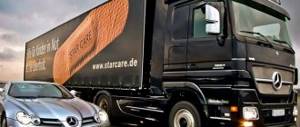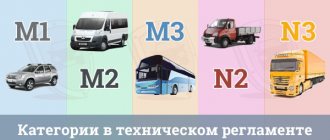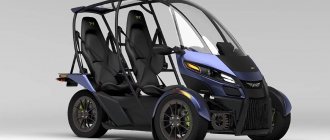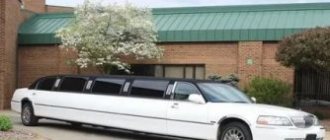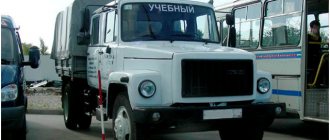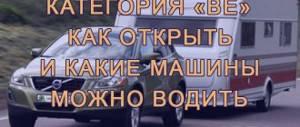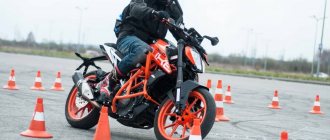Mopeds, motorbikes, mokikis
Vehicles equipped with two wheels, the maximum permissible speed of which cannot be higher than 50 km/h, belong to category L1. These vehicles may differ in technical characteristics, expressed in the following parameters:
- if there is an internal combustion engine, its total internal volume should not exceed 50 cm3;
- If there is an electric motor, the maximum power in continuous load modes should not exceed 4 kW.
Vehicles equipped with three wheels and with a permitted maximum speed of 50 km/h. belong to the L2 category. The following restrictive characteristics are established for such vehicles:
- if an internal combustion engine is installed, its volume should not be more than 50 cm3;
- if an electric motor is installed, its maximum power should not exceed 4 kW;
- ICEs of other types are also limited to a power parameter of 4 kW.
In the case of three-wheeled vehicles, their location on the frame of the device does not matter.
We are on Twitter:
Login Registration
Automotive news
Rules for the movement of heavy trucks in the automatic weight control zone have been adopted. The Federal Tax Service has approved the application form for the death or destruction of a vehicle. In Russia, it is forbidden to disembark children without a ticket from buses. A new sign 6.22 has been introduced in the traffic rules - “photo and video recording” Testing for alcohol dependence has been postponed for another year. The Ministry of Health has updated the requirements for completing car first-aid kits, the Ministry of Transport has approved the procedure and terms for storing diagnostic maintenance cards. Obtaining permission for international transport will now be done in a new way. You can now check your MTPL policy for authenticity online. The Central Bank has set new tariffs for MTPL.
/ Legal articles on the topic of automobile law / Miscellaneous / Vehicles of category M1
Vehicles of category M1
The Technical Regulations of the Customs Union on the safety of wheeled vehicles is a document that reflects all the requirements that are planned to be imposed on vehicles. Category M-1 in this act is one of the largest groups of vehicles.
Basic provisions
A feature of the new regulations is the division of vehicles into special categories that ordinary motorists have not encountered before. In total the following varieties are found:
- L1-L2. They include two-wheeled vehicles with engines up to 50cc. Attention is also paid to the maximum speed of such equipment: it should not exceed 50 km/h. If an electric motor is installed, its maximum power can be up to 4 kW.
- L3-L5 – motorcycles and tricycles. The category is designed for two- and three-wheeled vehicles with an engine capacity above 50 cc. cm, and the speed exceeds 50 km/h. Essentially, these are all motorcycles and other equipment that in a simple UL belong to category A.
- L6-L7 – ATVs. This is a four-wheeled vehicle, the mass of which is not higher than 350 kg, the speed is not higher than 50 km/h, if an internal combustion engine is installed, its volume should not exceed 50 cubic meters. see. For an electric motor, the power limit is 4 kW. This also includes similar vehicles weighing 400-550 kg, if the latter are designed to transport goods. The power of the gasoline engine is not limited, the electric motor is up to 15 kW.
- M1 is the largest category and denotes passenger cars.
- M2-M3 – vehicles for transporting passengers, including trolleybuses.
- N1 – it includes vehicles for cargo transportation that do not have additional passenger seats; the weight of vehicles in this category should not exceed 3500 kg.
- N2 – this includes trucks weighing more than 3.5 tons, but not exceeding 12 tons
- N3 – any trucks whose weight exceeds 12 tons.
- O1-O4 – trailers for vehicles. The main criterion for classifying these subcategories is the difference in the weight of trailers and their maximum carrying capacity.
This article will focus only on passenger cars, since they are the most common type of equipment about which questions are most often asked. The Customs Union includes passenger cars with up to 8 passenger seats in the M1 category. If we compare it with a regular driver’s license, these are all cars belonging to category B.
Category B gives the right to drive any vehicle weighing less than 3500 kg. There cannot be more than eight passenger seats; it is permissible to use a trailer with a load capacity of up to 750 kg. Such vehicles include cars, SUVs, minibuses, and light trucks. Category M-1 will include those requirements of technical regulations that are of interest to car owners. At the same time, if you have a vehicle that belongs to category B, but is a cargo vehicle, the Customs Union does not classify it as M-1 and uses another group for identification - M-2.
What is included in the M-2 category?
This group is a fairly broad category that includes all passenger modes of transport. It does not coincide with the categories allocated for them in the VU. This includes vehicles weighing up to 5 tons; the permitted number of passenger seats must be more than eight. For equipment weighing more than 5 tons, there is its own category - M-3.
It is worth noting that buses and trolleybuses can be classified as either M-2 or M-3 depending on their weight. When compared with a regular driver's license, M-2 and M-3 will correspond to categories C and D depending on the type of vehicle and its weight. The traffic police uses other rules that regulate the technical inspection process, namely the Requirements for vehicles in operation. That is why, when clearing equipment through customs, representatives of the road inspection will be interested in the first act, and when registering – in the second.
Time frame for investigating a criminal case of an accident
Rules for transporting goods on a passenger trailer
vehicle categories
86523
No comments yet. Yours will be the first!
Write a comment
New comments
Badyrgy → Removal and expungement of a criminal record under Art. 264.1 of the Criminal Code of the Russian Federation 21 hours ago
Convicted in 2014 of Part 1 of Article 264 of the Criminal Code of the Russian Federation with restriction of freedom and deprivation of rights for 1 year. How to expunge a criminal record? And where to go
Vladimir → Is it necessary to give way to a bus leaving the bus stop… 15 days ago
The rules state that the driver must give way to a bus departing from a stop within the city limits, but I drive at a speed of 60 km per hour at the main speed...
Automotive Lawyer → Deprivation of the right to drive under Art. 264 of the Criminal Code of the Russian Federation. About the most... 1 month ago
Hello. The period of criminal punishment in the form of deprivation of the right to drive runs, regardless of whether the vehicle is passed or not. The traffic police have been punished for enforcing this...
Evgeniy → Deprivation of the right to drive under Art. 264 of the Criminal Code of the Russian Federation. About the most... 1 month ago
Good evening! In 2014, he was convicted under Part 264 of the Criminal Code and served a real sentence of 2 years in a penal colony; the court also deprived him of his license for 3 years, after...
Automotive Lawyer → Deprivation of the right to drive under Art. 264 of the Criminal Code of the Russian Federation. About the most... 1 month ago
Hello. The terms of deprivation under the article of the Code of Administrative Offenses of the Russian Federation and under the article of the Criminal Code of the Russian Federation are not cumulative. Each term is calculated independently, i.e., independently of each other
Motorcycles, scooters, tricycles
The traffic rules also provide for other subcategories for vehicles with limited characteristics:
- L3 - vehicles equipped with two wheels, the volume of the internal combustion engine of which should not be higher than 50 cm3. The maximum speed allowed by their design characteristics is 50 km/h;
- L4 – mechanisms for movement, equipped with three wheels, which are located asymmetrically with respect to the longitudinal line of the vehicle. The working volume of their internal combustion engines is no more than 50 cm3. Structurally permissible maximum speed is 50 km/h;
- L5 – category having characteristics identical to L4;
The main difference between these categories is the distance between the points of contact of the wheels with the road surface. If this value does not exceed 46 cm, the vehicle belongs to category L3.
To drive vehicles of subcategories L3-L5, you must obtain a driver's license with open category A.
ATVs
ATVs are vehicles belonging to subcategory L6. Their maximum weight, without additional cargo, should not exceed 350 kg. The weight of the batteries is not taken into account if the vehicle is powered by an electric motor. For such units, the maximum permissible speed is 50 km/h.
Subcategory L7 has similar parameters, with the exception of the maximum unladen weight. This value should not exceed 400 kg. for ordinary vehicles and 550 for trucks.
To operate an ATV of subcategory L6, you must open category M. For those ATVs that have increased power parameters, you will need to open category B1.
Category O
Category O – Trailers (semi-trailers) for vehicles of categories L, M, N, including: (Note by ASMAP).
Category O1 – Trailers whose technically permissible maximum weight is not more than 0.75 tons.
Category O2 – Trailers with a technically permissible maximum weight of more than 0.75 tons, but not more than 3.5 tons.
Category O3 – Trailers with a technically permissible maximum weight of more than 3.5 tons, but not more than 10 tons.
Category O4 – Trailers with a technically permissible maximum weight of more than 10 tons.
A vehicle with no more than eight seats, excluding the driver's seat, intended for the carriage of passengers and goods, belongs to the category:
- M1, if the product of the number of passengers provided for by the design by the conditional mass of one passenger (68 kg) exceeds the estimated mass of cargo transported simultaneously with passengers;
- N if this condition is not met.
A vehicle designed for the transport of passengers and goods, having, in addition to the driver's seat, more than eight seats, belongs to category M.
In short, then
- M1 – vehicles used for the transport of passengers and having, in addition to the driver’s seat, no more than eight seats;
- M2 – vehicles used for the transport of passengers, having, in addition to the driver’s seat, more than 8 seats, the technically permissible maximum weight of which does not exceed 5 tons;
- M3 – vehicles used for the transport of passengers, having, in addition to the driver’s seat, more than 8 seats, the technically permissible maximum weight of which exceeds 5 tons;
- N1 – vehicles for the transportation of goods, having a technically permissible maximum weight of no more than 3.5 tons;
- N2 – vehicles intended for the transportation of goods, having a technically permissible maximum weight of over 3.5 tons, but not more than 12 tons;
- N3 – vehicles intended for the transportation of goods, having a technically permissible maximum weight of more than 12 tons;
- O1, O2 – trailers, the technically permissible maximum weight of which is not more than 3.5 tons;
- O3, O4 – trailers, the technically permissible maximum weight of which is over 3.5 tons;
- L – motor vehicles.
Categories and subcategories of vehicles on a driver's license
Old licenses and new categories in the driver's license
They took the car to the impound lot
How to open a new category of rights
Transport categories open up the possibility of undergoing specialized training at a driving school. The opening of a category for a more complex vehicle is accompanied by passing a full examination. If it is necessary to open subcategories within a category, some exams may be canceled because the applicant has already passed them when receiving a licence.
The complex of examination activities includes testing of theoretical knowledge and practical skills. To open an additional category, you need to submit a request to the driving school and receive information about the requirements that apply in this case.
Passenger vehicles
Passenger cars
Category M1 - Vehicles used for the transport of passengers and having, in addition to the driver's seat, no more than eight seats - passenger cars.
Let's consider category M1, which refers to passenger vehicles. It is this category that will be of interest to most car owners, since category M1 corresponds to category B of a regular driver’s license.
So if you are looking for requirements related to a passenger car in the technical regulations, then you should pay attention exclusively to the items related to the M1 category.
Please note that Category M1 does not include goods vehicles of Category B. These will be discussed below.
Buses, trolleybuses, specialized passenger vehicles
Category M2 - Vehicles used for the transport of passengers, having, in addition to the driver's seat, more than eight seats, the technically permissible maximum weight of which does not exceed 5 tons.
Category M3 - Vehicles used for the transport of passengers, having, in addition to the driver's seat, more than eight seats, the technically permissible maximum mass of which exceeds 5 tons
Passenger buses and trolleybuses, depending on their weight, fall into categories M2 and M3. Thus, categories M2 and M3 correspond to category D of a regular driving license.
In addition, if the bus has from 1 to 8 passenger seats, then the vehicle belongs to category B.
Category L1 (motor vehicles)
There are as many as 7 types of different motor vehicles, which are sometimes very difficult to understand. Let's briefly describe each of them:
- L1 - two-wheeled vehicles capable of traveling at a speed of no more than 50 km/h and having an engine displacement of no more than 50 cc. (with a power of no more than 4 kW);
- L2 - three-wheeled vehicles with a maximum speed of up to 50 km/h and an engine capacity of not more than 50 cc. (with power up to 4 kW).
Vehicle categories L1 and L2 are represented mainly by mopeds, scooters, motorbikes and motorcycles, which require a driver category M to operate.
If a moped has two wheels, then it belongs to the L1 category, and if it has three, it belongs to L2.
Other categories of motor vehicles:
- L3 - two-wheeled vehicles with an engine displacement of more than 50 cc. and with a maximum speed of more than 50 km/h;
- L4 - three-wheeled vehicles of an asymmetrical type (for example, motorcycles with a sidecar), the engine displacement of which is more than 50 cc. and a maximum speed of more than 50 km/h;
- L5 - three-wheeled vehicles of a symmetrical type (for example, motorcycles with a body located in the center) with an engine capacity of more than 50 cc. and a maximum speed of more than 50 km/h.
To drive motorcycles, tricycles and scooters from categories L3, L4 and L5, driver category A is required.
The last two groups of motor vehicles include quadricycles:
- L6 - low-power quadricycles with an unloaded weight of less than 350 kg and a maximum speed of no more than 50 km/h (essentially these are mopeds, that is, driver category M);
- L7 - powerful four-wheeled vehicles (quadricycles) with a maximum weight of up to 400 kg or with a weight of up to 550 kg if they are used to transport goods. The engine power of such quadricycles should not exceed 15 kW. Driving subcategory B is required to drive powerful quadricycles.
Vehicles in categories L6 and L7 differ almost exclusively in engine power.
Correspondence of vehicle categories and rights
Drivers often try to find out what category of license they need to have to drive a particular vehicle.
- to drive a passenger vehicle of category "M1" you will need the designation "B". Citizens need this category of license to drive a car every day. It is important to know that the “M1” category does not include trucks that fall under the “B” designation on their license;
- You can drive vehicles of categories “M2” and “M3” with a driver’s license with the designation “D”;
- vehicles falling under category “N1” can be driven with the common designation “B” on the driver’s license;
- to operate cars “N2” and “N3” you need category “C”;
- driving a car with a trailer weighing no more than 750 kilograms is possible with the usual category “B”;
- and for the categories “O1”, “O2”, “O3” the designations “E” to “B”, “E” to “C” and “E” to “D” on the license are suitable;
- To drive a vehicle of category “L1” - “L2”, you need category “M” on your driver’s license;
- You can drive a vehicle of category “L3” - “L5” with the designation “A”;
- You can legally drive a vehicle “L6” - “L7” if you own category “B1”.
When choosing your vehicle, be sure to check whether you have the ability to drive it. You can do this by looking at the designations that are on your driver’s license. If your category does not allow you to drive a certain vehicle, then its operation in the future may lead to the deprivation of your driver's license. Given such a serious punishment, we need to take this moment extremely seriously. Remember, you can also receive a punishment if you transfer your vehicle to a citizen whose category of rights does not allow him to drive this car.
Source
Category M
The TS-M group includes four-wheeled vehicles that are used for passenger transportation.
Vehicles of category M1 include a passenger car - a 4-wheeled vehicle, if the number of passenger seats without a driver does not exceed 8. The main requirement is that the car engine should not be more than 50 cubic meters, and the electric motor power should not be more than 4 kW.
Technical regulations are documentation regulating any type of product for the purpose of checking quality according to standards.
For example, for cars, technical regulations are used to establish technical inspection requirements for a diagnostic card. Standards help to ensure traffic safety and improve technical inspection quality.
M2 - vehicles included in group M, which have more than 8 seats for transporting passengers, for example, a bus. The total weight of such a vehicle should not exceed 5 tons.
Category M3 according to the technical regulations of the vehicle - cars with seats for more than 8 passengers, the total weight of the car exceeds 5 tons.
Classification of vehicles by category
The legislator introduced new types of categories and subcategories in 2013, which was dictated by the emergence of new types of vehicles in the country. For certain types of categories, additional training is required to obtain the right to drive.
For example, to drive an ATV, you take a qualifying exam to become a tractor driver.
What categories are there?
In accordance with the standards of legislative acts, ten categories and six subcategories of vehicles are established. Each of them corresponds to a specific type of transport, which has characteristics and distinctive features unique to it. These include:
How are they decrypted?
Category “A” includes vehicles equipped with two wheels. Group “A1” includes motorcycles with a maximum power of 11 kW and a displacement of 50-125 m3.
A driver's license of a separate category allows you to drive only vehicles assigned to a particular group.
For example, category “B” allows you to drive exclusively passenger cars. The driver is deprived of the right to drive a minibus or bus. He can drive these types of vehicles if he becomes the holder of a category “D” driver’s license. Category “C” includes trucks whose direct purpose is to transport goods, regardless of their weight and dimensions.
Small trucks, which are represented by category “C1,” are combined into a separate group.
City public transport, which transports people, is included in a separate group. The categories for trams and trolleybuses are designated “Tm” and “Tb” respectively. Special educational programs have been developed in training centers to train people who want to manage them. As for the category of vehicles M1 M2 M3, this is how vehicles intended for transporting people are designated. They differ in the number of seats for passengers.
Category M1 means that this vehicle is equipped with no more than eight seats in addition to the driver’s seat.
These include some types of passenger cars that carry passengers. For example, a minibus operated as a minibus. Category M2 includes vehicles with a permissible weight, which should not exceed 5 tons. They are equipped with 8 to 10 seats.
Category M3 is represented by vehicles that are used to transport passengers.
They are equipped with seating for up to 20 people, but can also carry standing passengers.
In addition, special categories have been established for vehicles equipped with trailers whose weight exceeds 750 kg - “BE”, “CE”, “DE”, “C1E”, “D1E”.
How to get
An interested person can obtain a driver's license by submitting an application to the traffic police at his place of residence or residence, at his place of actual residence, regardless of his place of registration.
It must undergo training at a training center or driving school and pass exams on the completed course.
These include:
The practical exam is taken within 6 months after passing the theoretical exam.
What deserves special attention
According to the instructions, a fee must be paid for issuing a driver's license. Its size is determined by the type of media from which it is made.
For example, 500 rubles are paid for a paper document, and 2,000 rubles for a plastic document.
The car owner receives a 30% discount on its payment if the driver’s license is issued through a single portal of State and municipal services.
To receive a document, you need to register on its official website in order to gain access to your personal account. This is where the application is submitted. During registration, you are required to fill out a form where the applicant’s personal data is entered. They are sent to the service system by clicking on the “register” button. It checks the data provided by the applicant, after which the system sends an authorization code to his email.
It allows you to receive all the services provided by e-government.
The legislator allows obtaining a driver's license through the Multifunctional Public Service Center. This kind of opportunity appeared for citizens after the entry into force of new rules. But the procedure may drag on indefinitely.
The fee for car owners obtaining a driver's license for the first time, the national average cost of the procedure is 6,500 rubles.
For the provision of services by the regional examination commission for accepting the theoretical part, the payment is 1,000 rubles, the practical part is 3,500 rubles. In addition, about 2,500 rubles are spent on medical examination. A driver's license is considered valid for 10 years, after which it is subject to mandatory replacement. It can be replaced before its expiration date based on an application in connection with changes that have occurred in the life of the car owner.
The obligation to replace a driver's license is imposed by the instructions of the Federal Law.
They note that vehicle drivers are obliged to replace it on the grounds provided by the legislator. There is no need to re-pass the traffic rules qualification exam and the ability to drive a vehicle.
If you lose your driver's license, the traffic police will issue a duplicate. To receive it, the driver must retake the traffic rules.
As for a lost document, it automatically goes into the category of invalid documents.
FAQ
Young people are interested in the possibility of obtaining a driver's license as a minor.
The legislator introduced changes to the resolution, which took effect in April of this year.
According to the innovations, they can obtain a driver’s license on a general basis. But they must obtain the consent of their legal representatives in the person of their parents or persons replacing them, which is drawn up in writing. Many citizens are interested in the right to drive category “M” vehicles.
They must take into account that they must have a driver's license of the appropriate category to drive a vehicle equipped with an engine whose displacement exceeds 50 cm3.
One of the issues of keen interest among citizens is the question of the timing of payment of state duties.
It must be paid in advance, before contacting the traffic police. The payment receipt is submitted along with the application and other required documents. Otherwise, his application for a driver’s license will not be considered by the traffic police.
The state duty can be paid both in cash and non-cash through a terminal located in the traffic police, in any bank and online on the official website of the unified portal of state and municipal services.
Video: vehicle categories
Trucks
Category N1 - Vehicles intended for the transport of goods, having a technically permissible maximum weight of not more than 3.5 tons.
Category N2 - Vehicles intended for the transport of goods, having a technically permissible maximum weight of over 3.5 tons, but not more than 12 tons.
Category N3 - Vehicles intended for the transport of goods, having a technically permissible maximum weight of more than 12 tons.
Trucks belong to category N of the technical regulations, within which they, like buses, are divided into subcategories by weight.
Trucks of category B correspond to category N1 of the technical regulations, trucks of category C correspond to categories N2 and N3.
Technical inspection
The requirements of technical regulations are clearly taken into account when passing technical tests. machine checks. This procedure is also carried out strictly in accordance with the law. It is required to identify faults and eliminate them, which helps ensure safety on the road.
When carrying out technical inspection is carried out:
- checking the machine itself;
- inspection of individual elements;
- checking additional equipment.
The working condition must be checked, as well as:
- steering play;
- operability of lighting devices and windshield wipers;
- braking system;
- composition of the first aid kit;
- degree of tinting;
- level of emissions of harmful substances.
Previously, after passing the MOT, you were given a coupon, which was attached to the windshield of the car. Now, if the vehicle check is successful, the owner will be given a diagnostic card. If violations are detected, you will have to correct them and return for inspection again. Not all drivers are required to carry a card with them. However, when applying for an insurance policy, it is included in the package of required documentation.
Technical regulations are necessary for carrying out technical procedures. checks. It approves special categories for each type of vehicle; they are reflected in the diagnostic card. Depending on the category of the vehicle, the center sets the cost of the technical inspection service.
